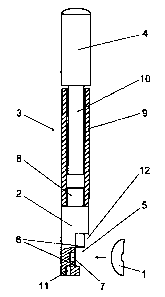Some of the information on this Web page has been provided by external sources. The Government of Canada is not responsible for the accuracy, reliability or currency of the information supplied by external sources. Users wishing to rely upon this information should consult directly with the source of the information. Content provided by external sources is not subject to official languages, privacy and accessibility requirements.
Any discrepancies in the text and image of the Claims and Abstract are due to differing posting times. Text of the Claims and Abstract are posted:
| (12) Patent Application: | (11) CA 2379724 |
|---|---|
| (54) English Title: | TOOL FOR INSERTING A THREADED PART INTO AN AREA DIFFICULT TO ACCESS |
| (54) French Title: | OUTIL SERVANT A PLACER UNE PARTIE FILETEE DANS UNE ZONE DIFFICILEMENT ACCESSIBLE |
| Status: | Deemed Abandoned and Beyond the Period of Reinstatement - Pending Response to Notice of Disregarded Communication |
| (51) International Patent Classification (IPC): |
|
|---|---|
| (72) Inventors : |
|
| (73) Owners : |
|
| (71) Applicants : |
|
| (74) Agent: | MARKS & CLERK |
| (74) Associate agent: | |
| (45) Issued: | |
| (86) PCT Filing Date: | 2000-08-02 |
| (87) Open to Public Inspection: | 2001-02-08 |
| Availability of licence: | N/A |
| Dedicated to the Public: | N/A |
| (25) Language of filing: | English |
| Patent Cooperation Treaty (PCT): | Yes |
|---|---|
| (86) PCT Filing Number: | PCT/DE2000/002558 |
| (87) International Publication Number: | WO 2001008851 |
| (85) National Entry: | 2002-02-04 |
| (30) Application Priority Data: | ||||||
|---|---|---|---|---|---|---|
|
A tool for inserting a threaded part (1), comprising a fixing head (2) that
holds the
threaded part (1) such that it cannot turn and is connected to the one end of
a guide rod
(3) while the other end projects from the area difficult to access. The object
of inserting a
threaded part, for example a nut, into an area difficult to access is solved
in that the fixing
head (2) is provided with a grooved recess (5) that extends at a right angle
to its
longitudinal axis and holds the threaded part (1) with frictional force, at
least in some
sections, between the two opposite-arranged, parallel surfaces (6), extending
in a
direction where the thread axis is at a right angle to the longitudinal axis
of the fixing
head (2).
L'invention concerne un outil servant à placer une partie filetée (1) dans une zone difficilement accessible et comportant une tête de maintien (2) qui reçoit la partie filetée (1), empêche sa torsion et peut être reliée à une extrémité à une barre de guidage (3) dont l'autre extrémité fait saillie hors de la zone difficilement accessible. L'invention vise à permettre le placement de la partie filetée, par exemple d'un écrou, dans une zone difficilement accessible. A cet effet, la tête de maintien (2) présente un évidement (5) en forme d'encoche et à angle droit par rapport à son axe longitudinal, qui reçoit en liaison de force la partie filetée (1) au moins partiellement entre ses deux surfaces parallèles opposées (6), dans une direction telle que l'axe du filetage est perpendiculaire à l'axe longitudinal de la tête de maintien (2).
Note: Claims are shown in the official language in which they were submitted.
Note: Descriptions are shown in the official language in which they were submitted.

2024-08-01:As part of the Next Generation Patents (NGP) transition, the Canadian Patents Database (CPD) now contains a more detailed Event History, which replicates the Event Log of our new back-office solution.
Please note that "Inactive:" events refers to events no longer in use in our new back-office solution.
For a clearer understanding of the status of the application/patent presented on this page, the site Disclaimer , as well as the definitions for Patent , Event History , Maintenance Fee and Payment History should be consulted.
| Description | Date |
|---|---|
| Application Not Reinstated by Deadline | 2006-08-02 |
| Time Limit for Reversal Expired | 2006-08-02 |
| Inactive: Abandon-RFE+Late fee unpaid-Correspondence sent | 2005-08-02 |
| Deemed Abandoned - Failure to Respond to Maintenance Fee Notice | 2005-08-02 |
| Letter Sent | 2003-01-10 |
| Inactive: Single transfer | 2002-11-06 |
| Inactive: Cover page published | 2002-08-02 |
| Inactive: Courtesy letter - Evidence | 2002-07-30 |
| Inactive: Notice - National entry - No RFE | 2002-07-25 |
| Application Received - PCT | 2002-05-07 |
| National Entry Requirements Determined Compliant | 2002-02-04 |
| Application Published (Open to Public Inspection) | 2001-02-08 |
| Abandonment Date | Reason | Reinstatement Date |
|---|---|---|
| 2005-08-02 |
The last payment was received on 2004-07-30
Note : If the full payment has not been received on or before the date indicated, a further fee may be required which may be one of the following
Please refer to the CIPO Patent Fees web page to see all current fee amounts.
| Fee Type | Anniversary Year | Due Date | Paid Date |
|---|---|---|---|
| Basic national fee - standard | 2002-02-04 | ||
| MF (application, 2nd anniv.) - standard | 02 | 2002-08-02 | 2002-02-04 |
| Registration of a document | 2002-11-06 | ||
| MF (application, 3rd anniv.) - standard | 03 | 2003-08-04 | 2003-07-16 |
| MF (application, 4th anniv.) - standard | 04 | 2004-08-02 | 2004-07-30 |
Note: Records showing the ownership history in alphabetical order.
| Current Owners on Record |
|---|
| ERICH FEILNER |
| Past Owners on Record |
|---|
| MARCUS FEILNER |